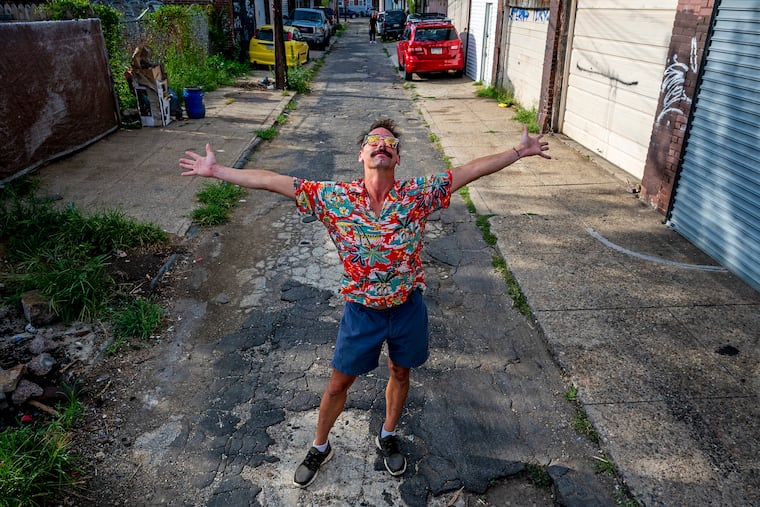A year later, Philly man who backflipped into the flooded Vine Street Expressway has no regrets
Justyn Myers — a 41-year-old architect and amateur cliff jumper — said the unplanned backflip was his way of making the best of a bad situation after the remnants of Hurricane Ida hit the region.

It was a deeply Philadelphian moment of comic relief.
A year ago this week, after the remnants of Hurricane Ida left a trail of destruction through the Philadelphia region, Justyn Myers left work, stripped down to his boxer briefs, climbed the guardrail along the 22nd Street overpass, and backflipped into the filthy floodwaters of the Vine Street Expressway.
The extraordinary flooding of the highway through Center City drew national attention to the clobbered region, even as the storm displaced hundreds of residents and caused at least $120 million in public infrastructure damage.
» READ MORE: From ‘in the river’ to eight feet up: How one family raised their house after Hurricane Ida
Myers — a 41-year-old architect and amateur cliff jumper — said the unplanned backflip was his way of making the best of a bad situation.
And a year later, he has no regrets.
“That was an easy one,” he said. “If the water wasn’t so dirty, I’d do that one again.”
This being Philly, Myers wasn’t the only one to get intimate with Vine Street after the Schuylkill overflowed and turned the usually bustling thoroughfare into a grimy canal. Another man was photographed tubing down the highway with a baseball hat and what appeared to be a cold beverage. Officials were forced to issue an unusual public warning: Don’t swim in the flooded highway. And if you already did, get a tetanus shot.
(In the sole interview he gave at the time, Myers said he took a 20-minute hot shower and returned to work that afternoon.)
The jump marked one of the weirder moments of 2021. But the self-described “carpe diem” enthusiast is no stranger to public shenanigans.
He’s the longtime captain of the Lobster Club Mummers Brigade. He was the brainchild behind the famous “dumpster pool” at his block party in Fishtown, and its popularity led to the city’s cracking down on renting trash cans and filling them with water. Last summer, he helped promote an impromptu roller disco at a roundabout in Fishtown before the city opened the new traffic circle to vehicles.
And his cliff-jumping hobby, which he documents on Instagram, has continued to grow since Vine Street. Myers said he recently suffered a collarbone injury after jumping off an 80-foot bridge in Upstate New York, but he still forged ahead with a five-day motorcycle tour.
“I broke it on the first day and I continued the whole trip, jumping and all,” he said, noting that the urgent care in New York had told him the bone wasn’t broken. Back home in Philly, his doctor determined within seconds that it was.
For the stunt on Vine Street, Myers said he took precautions to assess the depth of the filthy brown waters.
“I remember I was looking at the expressway on Street View via Google Maps, and I see there’s a sign here, and I now can’t see the sign,” he said. “So I figured the water must be at least eight feet deep. That’s plenty.”
Although Myers suffered no repercussions, many observers were repulsed by the potential health risks of submerging in the floodwaters. A year later, city officials are still shaking their heads over the stunts of that week.
“We really shouldn’t have to say this,” said city spokesperson Joy Huertas, “but things no one should do in polluted floodwaters include backflips, tubing, and really anything involving contact.”
The cleanup process itself was much less humorous.
To dredge the flooded highway, PennDot crews spent four days using eight pumps to drain water and mud. Crews worked overnight to get the road drivable again in time for the Made in America festival that drew thousands to the Benjamin Franklin Parkway.
Made in America is returning this weekend — this time, without the aftermath of a deadly storm. But future flooding on Vine Street remains a real possibility.
PennDot, which manages the expressway, noted at the time that the subterranean water pumps were not designed to handle flooding of the magnitude that the city saw during Ida. While the state agency manages infrastructural improvements, the city’s Huertas said federal infrastructural aid could provide “an unprecedented opportunity to plan and design for resiliency in transportation projects.”
“As funding opportunities are announced, the City will review them for their ability to fund the retrofit, upgrade, or rebuilding of outdated or under-designed infrastructure,” she said.